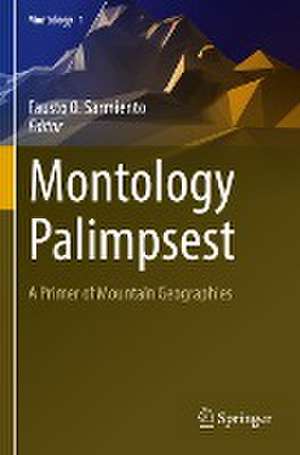Montology Palimpsest: A Primer of Mountain Geographies: Montology, cartea 1
Editat de Fausto O. Sarmientoen Limba Engleză Paperback – 3 ian 2024
This book introduces an innovative approach to sustainable and regenerative mountain development. Transdisciplinary to biophysical and biocultural scales, it provides answers to the "what, when, how, why, and where" that researchers question on mountains, including the most challenging: So What! Forwarding thinking in its treatment of core subjects, this decolonial, non-hegemonic volume inaugurates the Series with contributions of seasoned montologists, and invites the reader to an engaging excursion to ascend the rugged topography of paradigms, with the scaffolding hike of ambitious curiosity typical of mountain explorers.
Chapter 8 is available open access under a Creative Commons Attribution 4.0 International License via link.springer.com.
| Toate formatele și edițiile | Preț | Express |
|---|---|---|
| Paperback (1) | 1227.67 lei 6-8 săpt. | |
| Springer International Publishing – 3 ian 2024 | 1227.67 lei 6-8 săpt. | |
| Hardback (1) | 1234.00 lei 6-8 săpt. | |
| Springer International Publishing – 2 ian 2023 | 1234.00 lei 6-8 săpt. |
Preț: 1227.67 lei
Preț vechi: 1497.16 lei
-18% Nou
Puncte Express: 1842
Preț estimativ în valută:
234.92€ • 245.77$ • 195.14£
234.92€ • 245.77$ • 195.14£
Carte tipărită la comandă
Livrare economică 02-16 aprilie
Preluare comenzi: 021 569.72.76
Specificații
ISBN-13: 9783031133008
ISBN-10: 3031133005
Ilustrații: XIX, 506 p. 125 illus., 119 illus. in color.
Dimensiuni: 155 x 235 mm
Greutate: 0.73 kg
Ediția:1st ed. 2022
Editura: Springer International Publishing
Colecția Springer
Seria Montology
Locul publicării:Cham, Switzerland
ISBN-10: 3031133005
Ilustrații: XIX, 506 p. 125 illus., 119 illus. in color.
Dimensiuni: 155 x 235 mm
Greutate: 0.73 kg
Ediția:1st ed. 2022
Editura: Springer International Publishing
Colecția Springer
Seria Montology
Locul publicării:Cham, Switzerland
Cuprins
1. Introductory remarks.- Part 1: The Pioneering Dimension.- 2. Mountain Studies and Research in the Eighteenth Century: The Contributions of Horace Bénédict de Saussure and Alexander von Humboldt to the Study of Mountains.- 3. Mountain Development Adventure: The Hillary Model behind the Hillary Medal.- 4. Historical and Contemporary Contributions of the “Climber-Scientist” to Mountain Geography.- Part 2: The Human Dimension.- 5. Geopolitical and Cultural Appropriations: ‘Mountain’ as a Social Construct.- 6. Human Diversity, Identities, and Indigeneity in Contrasting Mountain Landscapes.- 7. Mountain Landscapes as “Lifescapes”: Sustaining Traditional Biocultural Heritage and Supporting Resilience in the Asia-Pacific Region.- 8. Urbanization and the Verticality of Rural–Urban Linkages in Mountains.- Part 3: The Physical Dimension.- 9. Trends of Land Use and Land Cover Change in Mountain Regions.- 10. Atmospheric Envelopes and Glacial Retreat.- 11. Mountain Landslides – An Overview of Common Types and Future Impacts.- 12. The Spiritual and Cultural Importance of Mountains.- 13. A Biocultural Ethic for Coinhabiting Mountainous Rivers.- 14. High Altitude Archaeology and the Anthropology of Sacred Mountains: 25 Years of Explorations and Diseminations.- Part 5: The Biogeographical Dimension.- 15. The Paleoecological View from the Mountains.- 16. Mountain Waterscapes: Geographies of Interactions, Transformations and Meanings.- 17. Biogeography of Knowledges in the Mountainous Anthropocene: Hybrid Conceptual and Practical Spaces within the GeoHumanities.- 18. Agrobiodiversity in Mountain Territories: Family Farming and the Challenges of Social-Environmental Changes.- Part 6: The Conservation Dimension.- 19. Construction of Disaster Risk in Mountain Systems and its Integrated Management.- 20. Population Movements, Colonization Trends and Amenity Migrants in Mountainscapes.- 21. Mountain Protected Areas and Ecotourism for Sustainable Development: A Case Study of Ecuador.- 22. Mountain Biosphere Reserves as Model Territories: Reconciling the Goals of Biological/Cultural Heritage Conservation and Development.- 23. World Heritage and Mountain Sites.- Part 7: The Epistemological Dimension.- 24. Ecosystem Services and Benefits of Nature to People: Global Change Pressures and Conflicts of Use in Mountainscapes.- 25. Metascientific Approaches to Montology.- 26. Terminology and Argot Woes in the Corpus of Mountain Geographies.- 27. Conclusion.
Notă biografică
Prof. Dr. Fausto O. Sarmiento has been involved in major disciplinary and institutional change processes to promote sustainable development in mountain environments and in restructuring evaluation criteria used for landscape conservation in the Tropical Andes. He was Regional Editor for Latin America for the journal Mountain Research and Development, and is Editorial Board member of Pirineos, the Journal of Mountain Ecology, the Journal of Mountain Science, the Journal of High Andean Research and the Annals of the AAG. He serves in advisory boards of global mountain organizations and represented the International Human Dimension Program of Global Environmental Change to the Science Board of the Mountain Research Initiative (MRI). He was chair of the Mountain Geography Specialty Group (2002-3 and 2014-5) of the Association of American Geographers (AAG), is chair of the International Geographical Union’s Commission on Mountain Studies (IGU), and former president of the Andean Mountains Association (AMA). Currently, he is deputy Vice Chair (Capacity Building) of the Mountain Biome of the World Commission of Protected Areas (WCPA), member of the Board of the Satoyama Initiative of the United Nations University (UNU), member of the board of the Earth Ethics Institute (EEI) and member of the Protected Landscapes Task Force in the World Conservation Union (IUCN).
Textul de pe ultima copertă
This book introduces an innovative approach to sustainable and regenerative mountain development. Transdisciplinary to biophysical and biocultural scales, it provides answers to the "what, when, how, why, and where" that researchers question on mountains, including the most challenging: So What! Forwarding thinking in its treatment of core subjects, this decolonial, non-hegemonic volume inaugurates the Series with contributions of seasoned montologists, and invites the reader to an engaging excursion to ascend the rugged topography of paradigms, with the scaffolding hike of ambitious curiosity typical of mountain explorers.
Chapter 8 is available open access under a Creative Commons Attribution 4.0 International License via link.springer.com.
Caracteristici
Conceptual re-framing of mountain geography in space and time continuum rather than static elements Presents structure, function and change of the mountainscape as one integral entity Redefines mountains as contentious landscape constructs in broader socio-ecological terms Chapter 8 is available open access under a Creative Commons Attribution 4.0 International License via link.springer.com
